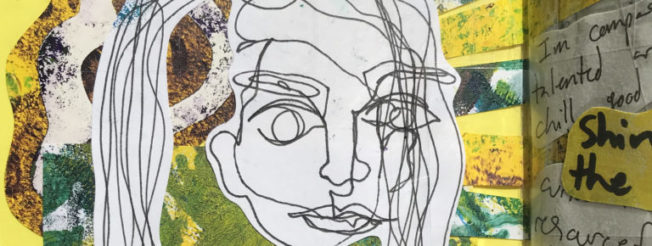Environmental Art Education
- Empathy
- The Teacher and Peers
- Reflecting
- Bigger Issues

Environmental Art Education
Another approach that is important to me is Environmental art, or Eco-art, which combines art education and environmental education.
Empathy
One of the biggest focuses is developing empathy, both with other people and with non-humans like plants, animals, and the environment. This involves thinking of oneself as part of a community with the world, not just humans, like an ecosystem which relies on diversity and relationships. In a study I read (cited below), they talked about how students do really enjoy engaging with the environment; they only dislike it when they have no knowledge or experience about the environment, hence the bad habits we’ve developed as a society. Art is a really good method for developing empathy since you see so many different views and feelings through peer art, and with critiques you have a chance to help your peers improve and act on empathy. Eco-art connects to empathy with that as well as participating in engaging with nature like caring for plants or going out and connecting with a specific place.
The study also mentioned how just observing nature while drawing it can lead to empathy. This made me think of meditative activities when you do something repetitive or methodical or you become really focused in an activity that doesn’t involve speaking or reading, it allows you to think about whatever’s on your mind. In this case, observing and drawing plants is very focused and quiet so it allows students to think about the plant and nature, admire it, and even meditate on it my letting your thoughts flow while drawing.
The teacher and peers
As with any class, the teacher should model the teachings. So, in this case it’s very important for the teacher to participate in activities as well as develop a positive relationship with the students. If the teacher is kind, caring, friendly, supportive, etc. then students learn from that behavior to be more caring (and therefore empathetic) themselves. It seems important for eco-art to be very student centered so students actually feel and develop the emotions and connections rather than them being pushed onto the student. This means the teacher has to have an even closer connections to students to interact and hear their individual thoughts and ideas for observation. Students can also develop close peer relationships through group activities to further encourage the empathy gain through working with other students, hearing other points of view, and combining skills.
Reflecting
Reflecting on connections with things, places, and organisms seems to also aid empathy. When you feel connected to something you start to care for it and actually desire to care for it. This is reflected in exploring environmental art through places special to the student, where they can think about how they connect to the place and why it’s special. That then can be prompted to think about the future of whatever you feel connected to, both the goods and bads – and think about how to make the goods actually happen. This leads to student engagement and reflection too by interacting with a place and thinking about the future. The same could be done with caring for a plant and thinking about how you impact it, how the plant depends on you, and the plant’s future. These things can be reflected on through self-reflections, discussions, and interpretive art works as well.
bigger issues
From those connections, students can learn about issues threatening their place and how to work against the issue. This is where environmental art education can teach about sustainability, environmental history, justice, and integrity to make the world or place the version students want to be reality. Art is very useful for communicating and reflecting on these thoughts and learnings that students will come across for art’s diverse outcomes and meanings, and even being inventive with art supplies to put sustainability, etc. into the student’s own practice. And, with these being such big issues, art can be a more concise but still deep method of communicating ideas. Art also has the benefit of being therapeutic for simultaneously dealing with the stress of worrying about the future if students do feel overwhelmed at all. This is a good reason for the order of starting with developing empathy and relationships and connections before moving onto discussing the issues so students feel the compassion to act through art rather than sit in anxiety from the sudden burden of world issues. With art, you can actually make change and this approach teaches that along with the empathy and reflection and resourcefulness.
References
- Sunassee, A.; Bokhoree, C. A Designed Eco-Art and Place-Based Curriculum Encouraging Students’ Empathy for the Environment. Ecologies 2021, 2, 248–267. https://doi.org/10.3390/ecologies2030014








